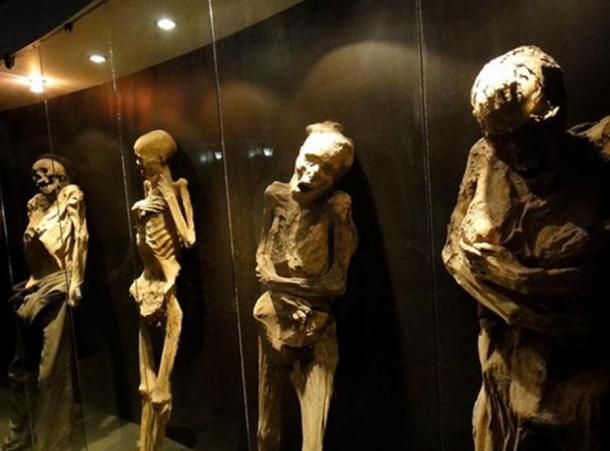Were extremely well preserved natural mummies discovered in Colombia made by special high altitude climatic conditions, or was it the fruit they consumed? The mausoleum of San Bernardo is located within the department of Cundinamarca, Colombia, high within the Andes and 40 miles (64.37 km) southwest of the country’s capital, Bogota. Characterized by high fertility agricultural land, the region offers the grower a variety of climates and today San Bernardo’s main products are blackberry and peas.
A high altitude mausoleum in San Bernardo, Colombia, holds a collection of more than a dozen so-called ‘natural mummies’. While no official scientific explanation accounts for how these mummies were formed, climatologists suspect they are caused by the chemical composition of the earth around San Bernardo. Locals, on the other hand, believe their ancestor’s diets included lots of Vitamin C packed guatila (chayote) that helped to create the extremely well-preserved natural mummies.

Locals believe that the natural mummies have been so well-preserved due to a diet high in guatila (chayote) fruit. ( teen00000 / Adobe Stock)
Debunking the Mystery of the Natural Fruit Mummies
We all know that a mummy is a dead human or an animal with preserved soft tissues, and most often mummies were chemically created during death rites. However, mummies can be made when a dead body is exposed to extreme cold, low humidity and thin high altitude air. According to a Daily Mail article, exactly why the San Bernardo collection is so well-preserved “is a mystery.”
The mystery lies in the gulf between what locals think happened and what scientists say happened. The latter believe the cold climate affected the chemical composition of the earth in some way, and that it caused the soils or air to embalm the corpses, while the former point to the native diet that included lots of guatila, a nutritious thorny green fruit. However, as romantic as the fruit preservation theory sounds, a lot of silence prevails when one politely asks the locals how the fruit managed to preserve the mummy’s clothes so well?

The natural mummies of San Bernardo, Colombia, on display at the mausoleum. (The Gringo / CC BY-NC-ND 2.0 )
The Mirror Mummies of San Bernardo
Discovered in the 1950s when a local cemetery was being relocated after a severe flood, and thought to date back around 100 years, this collection of well preserved bodies was first put on display for the public in 1994. Today, this high altitude Colombian mausoleum has become a very popular tourist attraction. The mummies can be seen wearing the clothes they were wearing when they died, and their well-preserved features, facial hair and fingernails are exceptionally stirring. Perhaps this is because they offer us a direct insight into a mirror of what we are all destined to become.
Unlike many mummies that remain anonymous having been found amidst the rubble left behind by treasure hunters , the San Bernardo bodies come with wooden plaques offering ghostly personal descriptions. “Margaria” was a homemaker who “always offered corn cakes and coffee to everyone.” Due to their genetic heritage, the bodies attract their current relatives, like for example, Ever Pabon, who according to the Wall Street Journal in 2015 visited his mummified father who still wears his “gray-checkered suit.” He even has a photograph of his mummified parent on the home screen of his smartphone.
Without Science, Everything Gets Fruity
“There’s something about the atmosphere around the village that keeps bodies from decomposing,” claims the Daily Mail , but the scientific specifics are yet unknown. Scientists draw similarities between the climate in this region of Colombia, with Guanajuato in Mexico, where underground gases affect the chemical composition of the surface soil, which in turn prevents the dead from rotting at a predictable rate.

Mummies in the museum in Guanajuato, Mexico. ( CC BY SA 4.0 )
Determining the scientific origins of the unusual, yet natural, mummification process at San Bernardo would require testing the mummies. And because relatives won’t grant permission, the mystery will continue to develop and evolve. Locals are insistent that because the region has a lot of guatila fruit, which is generally served in salads, that not only do they experience special health benefits while alive, but that they will also be naturally mummified when they die.
Top image: One of the natural mummies in San Bernardo, Colombia. Source: The Gringo / CC BY-NC-ND 2.0
By Ashley Cowie
 RSS Feed
RSS Feed















 March 4th, 2022
March 4th, 2022  Awake Goy
Awake Goy  Posted in
Posted in  Tags:
Tags: 













